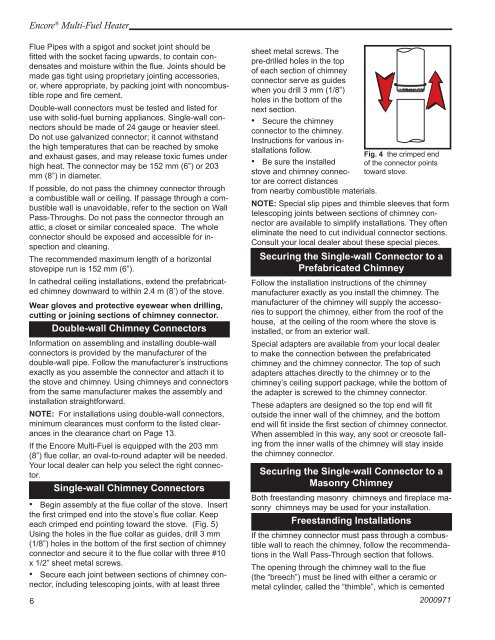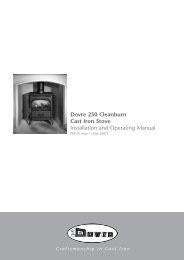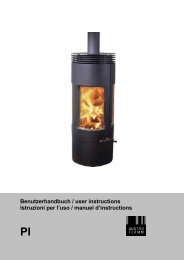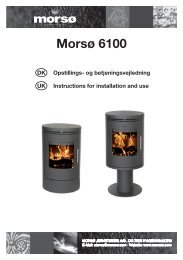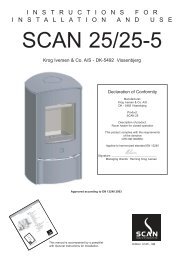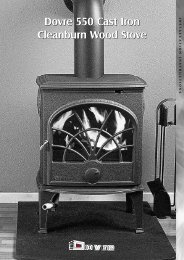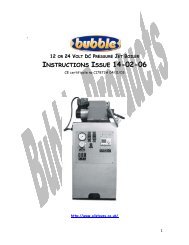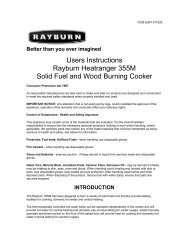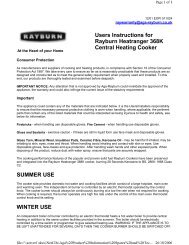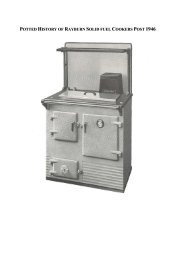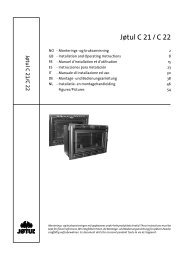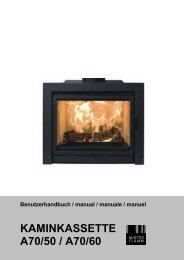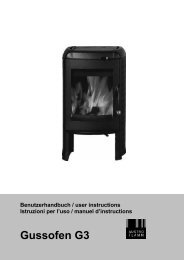Encore®
Encore®
Encore®
Create successful ePaper yourself
Turn your PDF publications into a flip-book with our unique Google optimized e-Paper software.
Encore ® Multi-Fuel HeaterFlue Pipes with a spigot and socket joint should befitted with the socket facing upwards, to contain condensatesand moisture within the flue. Joints should bemade gas tight using proprietary jointing accessories,or, where appropriate, by packing joint with noncombustiblerope and fire cement.Double-wall connectors must be tested and listed foruse with solid-fuel burning appliances. Single-wall connectorsshould be made of 24 gauge or heavier steel.Do not use galvanized connector; it cannot withstandthe high temperatures that can be reached by smokeand exhaust gases, and may release toxic fumes underhigh heat. The connector may be 152 mm (6”) or 203mm (8”) in diameter.If possible, do not pass the chimney connector througha combustible wall or ceiling. If passage through a combustiblewall is unavoidable, refer to the section on WallPass-Throughs. Do not pass the connector through anattic, a closet or similar concealed space. The wholeconnector should be exposed and accessible for inspectionand cleaning.The recommended maximum length of a horizontalstovepipe run is 152 mm (6”).In cathedral ceiling installations, extend the prefabricatedchimney downward to within 2.4 m (8’) of the stove.Wear gloves and protective eyewear when drilling,cutting or joining sections of chimney connector.Double-wall Chimney ConnectorsInformation on assembling and installing double-wallconnectors is provided by the manufacturer of thedouble-wall pipe. Follow the manufacturer’s instructionsexactly as you assemble the connector and attach it tothe stove and chimney. Using chimneys and connectorsfrom the same manufacturer makes the assembly andinstallation straightforward.NOTE: For installations using double-wall connectors,minimum clearances must conform to the listed clearancesin the clearance chart on Page 13.If the Encore Multi-Fuel is equipped with the 203 mm(8”) flue collar, an oval-to-round adapter will be needed.Your local dealer can help you select the right connector.Single-wall Chimney Connectors• Begin assembly at the flue collar of the stove. Insertthe first crimped end into the stove’s flue collar. Keepeach crimped end pointing toward the stove. (Fig. 5)Using the holes in the flue collar as guides, drill 3 mm(1/8”) holes in the bottom of the first section of chimneyconnector and secure it to the flue collar with three #10x 1/2” sheet metal screws.• Secure each joint between sections of chimney connector,including telescoping joints, with at least threesheet metal screws. Thepre-drilled holes in the topof each section of chimneyconnector serve as guideswhen you drill 3 mm (1/8”)holes in the bottom of thenext section.• Secure the chimneyconnector to the chimney.Instructions for various installationsfollow.• Be sure the installedstove and chimney connectorare correct distancesfrom nearby combustible materials.Fig. 4 the crimped endof the connector pointstoward stove.ST242Chimney connector12/13/99 djtNOTE: Special slip pipes and thimble sleeves that formtelescoping joints between sections of chimney connectorare available to simplify installations. They ofteneliminate the need to cut individual connector sections.Consult your local dealer about these special pieces.Securing the Single-wall Connector to aPrefabricated ChimneyFollow the installation instructions of the chimneymanufacturer exactly as you install the chimney. Themanufacturer of the chimney will supply the accessoriesto support the chimney, either from the roof of thehouse, at the ceiling of the room where the stove isinstalled, or from an exterior wall.Special adapters are available from your local dealerto make the connection between the prefabricatedchimney and the chimney connector. The top of suchadapters attaches directly to the chimney or to thechimney’s ceiling support package, while the bottom ofthe adapter is screwed to the chimney connector.These adapters are designed so the top end will fitoutside the inner wall of the chimney, and the bottomend will fit inside the first section of chimney connector.When assembled in this way, any soot or creosote fallingfrom the inner walls of the chimney will stay insidethe chimney connector.Securing the Single-wall Connector to aMasonry ChimneyBoth freestanding masonry chimneys and fireplace masonrychimneys may be used for your installation.Freestanding InstallationsIf the chimney connector must pass through a combustiblewall to reach the chimney, follow the recommendationsin the Wall Pass-Through section that follows.The opening through the chimney wall to the flue(the “breech”) must be lined with either a ceramic ormetal cylinder, called the “thimble”, which is cemented2000971


